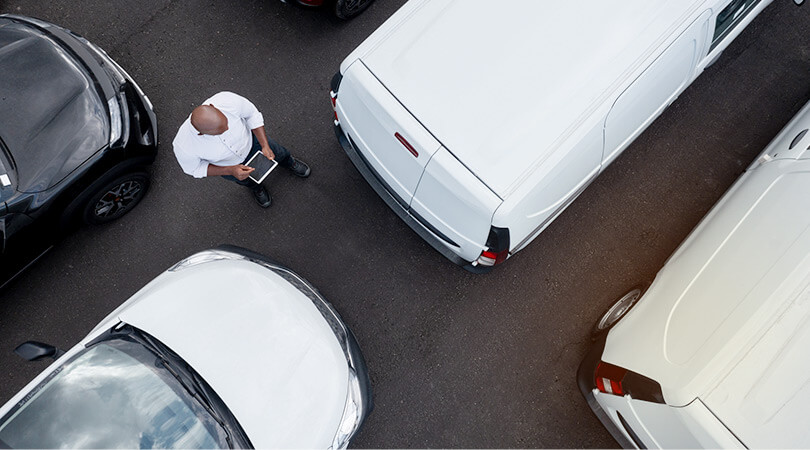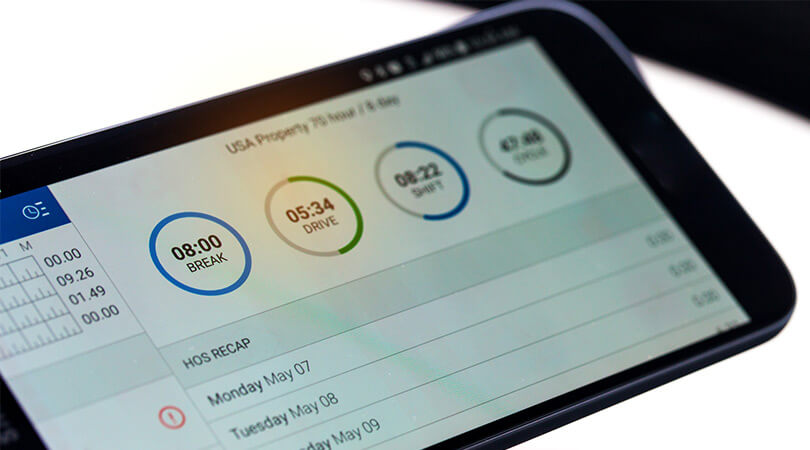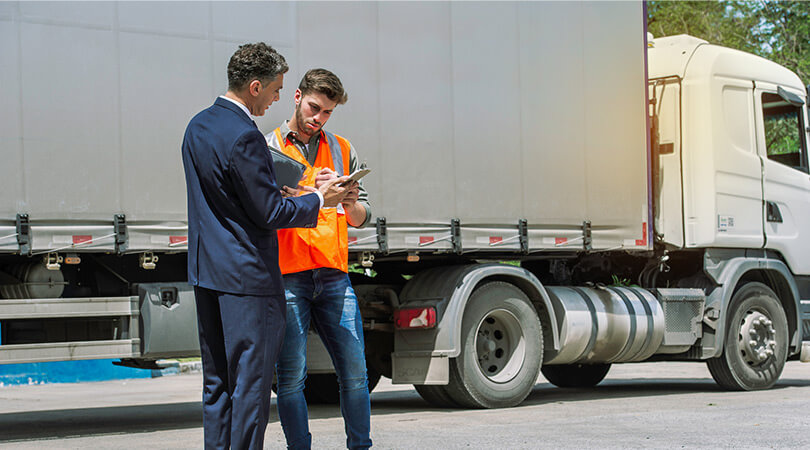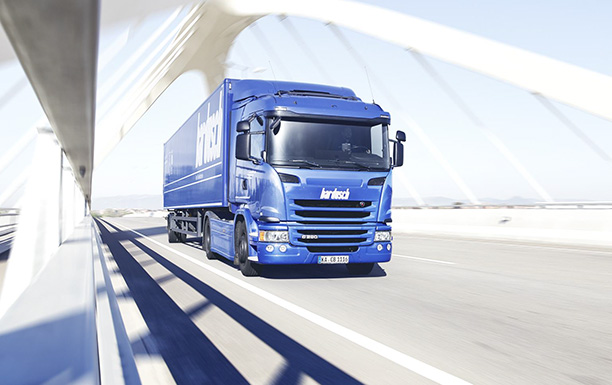

Smart solutions for Fleet Management
Get more information
Use case: Fleet operators and haulage companies are increasingly expected to make their CO2 footprint transparent and improve it. Besides the economic necessity to reduce fuel consumption and tyre wear, sustainability is steadily becoming a competitive advantage.
Challenge: Manual recording of the CO2 footprint is hardly affordable and can only be implemented through rough estimates. The reduction of empty runs gains additional importance in this context.
Solution: The route- and vehicle-specific recording of kilometres driven and fuel consumption enables you to evaluate CO2 emissions more precisely.
Your benefits: You can use data on actual CO2 emissions to reduce the ecological footprint of your fleet and use it as a competitive advantage.

Use case: As a fleet manager, you need an overview of your fleet – for example, when which vehicle needs to be inspected by the TÜV (MOT) or when leasing contracts expire. Important information also includes the loading capacities or the suitability for hazardous goods or refrigerated transport. In addition, there are the skills of the driving personnel, prescribed inspection dates, as well as the utilisation, i.e., the distance in kilometres each vehicle has achieved, so that the kilometre quotas of the leasing contracts are optimally utilised.
Challenge: Manual maintenance of master data in lists is very time-consuming, dates are quickly overlooked, km mileages are often only available in the logbook, which remains in the vehicle.
Solution: The fleet management tool enables the central systematic recording of all master data in one place, which can be easily linked for the evaluation of upcoming appointments. The usage of the vehicles also quickly becomes transparent and can be taken into account much more easily when planning deployments.
Your benefits: You gain maximum transparency of the vehicle fleet and the skills of the driving personnel. This enables you to improve deployment planning and optimise utilisation.

Use case: In the transport and forwarding industry, a number of legal requirements must be fulfilled. They range from regular driving licence checks to proof of training for the driving personnel to the keeping of a logbook and tachograph archiving.
Challenge: In order to avoid fines, legal deadlines must be adhered to and met, and checks are to be carried out and archived securely.
Solution: The measures to be carried out are implemented on schedule and automated. The driving licence check can be carried out by the driving personnel directly via app, independent of location and time. The driver's logbook is available digitally in compliance with the law and the tachograph records can be made available automatically.
Your benefits: You are relieved of the organisational effort required to comply with legal requirements and receive audit-proof and uniform documentation.

Use case: For billing customers and proving compliance with legal regulations, numerous data such as mileage, consumption, and driving times must be recorded.
Challenge: In order to provide proof of driving and resting times, for both billing purposes and to optimise fleet deployment, information is required that can no longer be recorded and processed manually.
Solution: Reports with filter functions for all important key figures are created in real time in compliance with the obligation to provide proof. The fleet deployment reporting system helps you by automatically generating overviews of kilometres driven, idle times, routes driven, speeds per route section, trip durations, staff deployment schedules, fuel logs, CO2 emissions and visit evaluations.
Your benefits: Extensive reporting on the individual vehicles and the fleet with different displays enables you to perform qualified evaluation of journeys and optimisation of fleet deployment.

Use case: Fleet controlling provides the key figures that enable economic decisions to be made in fleet management as well as for the invoicing of the services provided. It compiles all vehicle costs and relates them to vehicle or driver performance. This visualizes savings opportunities and measures for improvement.
Challenge: Fleet operators need information in order to procure the right vehicles, choose the most economical form of vehicle financing, optimise the use of vehicles, minimise ongoing vehicle operating costs, recognise the risk of accidents and damage and minimise the expense involved, as well as achieve the highest possible residual values when selling the vehicles.
Solution: With our solutions, all the data required for the monetary evaluation of vehicles and fleets is collected and clearly presented for decision-making.
Your benefits: The clear preparation of the data gives you a solid basis for financial decisions and allows you to objectively assess risks.

Use case: Digital route planning finds the best way between a starting point and a destination. In most cases, one or more locations in between ("via") can also be specified. Criteria can be specified whether the fastest, shortest or most economical route should be searched for. Complex algorithms are used to determine the optimal route.
Challenge: When planning their logistics orders, fleet operators have to plan according to time and economic constraints and at the same time take into account the availability of drivers and vehicles. Legal regulations, contractual agreements and forecast traffic situations must also be factored in. For larger fleets without software support, this is no longer possible in a cost-effective manner.
Solution: With our products, we support effective route planning to optimise costs and satisfy customers and recipients.
Your benefits: As a fleet operator, you can optimally schedule your fleet and drivers according to the order situation.

Use case: Fleet operators must carry out driving licence checks at regular intervals to ensure that their drivers are in possession of a valid licence and that it is suitable for the work they are doing. This is to ensure that legal requirements are met, that the fleet operator fulfils its duty of care towards its employees and that accidents are avoided.
Challenge: The checks of valid driving licences in the fleet grow with increasing employees and vehicles and can no longer be managed manually. Time-consuming coordination of appointments, on-site appointments for the driving personnel and documentation of the driving licence check are associated with a high organisational effort.
Solution: With our solution, driving licence checks are carried out digitally via an app and a control seal on the driving licence. It can be carried out by the driving personnel regardless of location and time, and the test data is immediately documented in the portal.
Your benefits: You do not have to perform manual checks via forms and visual inspections, thus reducing organizational effort.

Use case: The driver's logbook enables the automatic creation of route reports and visit evaluations, provides an overview of the staff and vehicle deployment plan, and determines the standing times of the vehicles. It also serves as an essential basis for invoicing and in the event of complaints. The data collected includes: distance driven, idle times, tank and emission data, driving time, speed, time recording, customer visits, operating hours, trailer information.
Challenge: The documentation of journeys by trucks and company cars is very time-consuming for fleet operators. In particular, the large number of vehicle movements and events concerning the vehicles as well as the requirements for planning and invoicing the fleet are associated with a high organisational effort.
Solution: With our solutions, all the data required for evaluating fleet movements is collected and made available in all the necessary formats for efficient decision-making and invoicing.
Your benefits: The digital driver's logbook significantly reduces your manual efforts in fleet management – especially in accounting. It also improves data quality through the automatic recording of journeys.

Use case: In addition to an overview of the vehicles themselves, fleet managers need an overview of other assets such as trailers, swap bodies, mobile superstructures and even soil vibrators or lawn mowers in landscaping.
Challenge: Mobile assets are used in very different ways. They get lost again and again and then have to be searched for at great expense, for example by driving around the construction sites.
Solution: Equipping the assets with Bluetooth beacons, for example, makes it possible to determine the last location of the assets. Valuable assets can be found again at any time thanks to autonomous tracking solutions. The effort required to search for lost assets or assets forgotten at construction sites is minimised. In case of theft of valuable assets, the last location can be tracked.
Your benefits: You can optimise the deployment planning of assets, because the current location can be viewed at any time. In the event of a theft of valuable assets, you can locate the last location.

Use case: Order management provides the driving personnel with all the necessary information to complete orders effectively. The in-vehicle transport logistics system provides the orders, locates the vehicle, and monitors the vehicle and the driver. It is used for trucks, vans, service vehicles, cars and heavy vehicles such as tractors, combine harvesters, pile drivers, tunnel construction machines and cranes.
Challenge: Drivers need to be informed directly about current and changed orders in order to make immediate decisions on driving style and route changes. This must therefore be done promptly in order to keep costs as low as possible in the event of order changes or changed general conditions (e.g., if a delivery is cancelled).
Solution: Our solution provided the driving personnel with the necessary information to adjust routes and driving behaviour in real time. The automated deployment and route planning leads to optimal results. In connection with an interface to the ERP system, orders can be transferred directly into the route planning, manual processes are no longer necessary.
Your benefits: You can significantly reduce your costs through immediate intervention in order processing and delivery and use your personnel and machines more efficiently.

Use case: Navigation involves determining the current position and finding the best route to the destination. The data in the vehicle is determined during the journey and shows the current status, which may deviate from the planning. As soon as the driver is on the road, the in-vehicle navigation gives him or her the route to be taken in real time. To avoid misunderstandings in case of last-minute changes in the planning, it is necessary that navigation and route planning interact.
Challenge: To avoid lost time in deliveries and to speed up order management, it is often necessary to adjust route planning and the current route at short notice. This can be necessitated by the acute traffic situation as well as by changes in order processing. For this to happen in real time, the in-vehicle navigation must be linked to the route planning.
Solution: With our solution, each route can be planned and clearly displayed so that your drivers can easily follow it and route changes are communicated immediately. Destination details support a quick delivery or pick-up.
Your benefits: You are able to make any necessary adjustments to the planned route during the journey. At any time, you receive predictions of the estimated time of arrival (ETA). This enables your driving staff to deliver and pick up efficiently.

Use case: The driving personnel frequently still use paper documents at the end customer's premises. Whether forms, delivery notes or checklists – handovers often have to be confirmed or countersigned.
Challenge: The use of paper documents often results in manual and error-prone additional work and the data is not available in real time.
Solution: The digitisation of forms such as delivery notes and the possibility of digitally recording the handover signature leads to the avoidance of paperwork.
Your benefits: Paperless document management can expedite your invoicing process. Optimised processes lead to more employee satisfaction and ensure better quality and service.

Any company that operates a fleet of vehicles, such as craft businesses, construction companies, freight forwarder or care services, needs a fleet management system. Such a system includes the coordination and monitoring of vehicles and equipment such as trailers or machines. Fleet management plays a critical role in optimising operational efficiency and minimizing costs. A significant part of this is documenting compliance with legal requirements – for example, proving that driving personnel have a valid driving licence. If your company owns a fleet of vehicles, the fleet management tools that we offer in collaboration with our partners can help you reduce costs, simplify usage, increase productivity, and boost customer satisfaction.
Our fleet management solutions collect data on vehicle usage, such as locations, routes, and consumption, and send it to a software solution in the cloud that you can access through your browser or an app on your phone. This automatic collection and aggregation of usage data can optimise operations in several ways:
- Simplified administrative effort:
The documentation required to prove compliance with legal regulations is a major challenge for fleet managers. Automatically capturing and merging data such as driving and rest times, entries in the digital driver's logbook, or proof of the current driver's valid permit simplifies this process and provides legal certainty. - Transparency over usage:
Location tracking as well as fuel level analysis provide a complete overview of vehicle usage, preventing misuse by employees or theft. - More efficient planning:
Position tracking by GPS allows dynamic route planning that also considers traffic jams or blocked routes. On the one hand, this reduces fuel consumption and cuts emissions, and on the other it leads to efficient delivery and higher customer satisfaction.
The term telematics is often used in connection with fleet management solutions. It is made up of the words telecommunications and information technology. Telematics hardware is installed in the vehicle, which contains a GPS transmitter and a SIM. This determines the vehicle's location data and sends it to the cloud via a cellular connection. A software solution processes the data and uses it for vehicle location in real time, reading, evaluating, and archiving digital tachographs or for driving style analysis. Telematics is therefore a crucial component of any fleet management solution.
There are several key benefits to implementing a fleet management system. Here are some examples.
- Improved asset utilization:
By monitoring vehicle usage and optimising routes, companies can maximise fleet productivity. - Increased safety and compliance:
Fleet management systems enable companies to monitor driver behaviour, perform proactive maintenance, and ensure compliance with safety regulations. - Cost savings:
By optimising fuel consumption, reducing maintenance costs and minimizing vehicle downtime, companies can achieve significant cost savings. - Simplified administration:
Fleet management systems automate administrative tasks such as scheduling, reporting and record keeping, leaving more time for strategic activities. - Improved customer satisfaction:
With more accurate route planning and delivery time information, companies can provide better customer service, which leads to higher customer satisfaction.
When selecting a fleet management solution, consider the following features:
- Real-time vehicle tracking and mapping:
This feature enables companies to monitor the location of their vehicles and make informed decisions based on real-time data. - Route optimisation:
Look for a solution that provides intelligent route planning to minimize fuel consumption, reduce travel time, and improve overall efficiency. - Maintenance scheduling:
A fleet management system should provide automated maintenance reminders and scheduling tools to ensure vehicles are being serviced at optimal intervals to reduce the risk of breakdowns. - Monitoring driver behaviour:
The ability to track driver behaviour, such as speeding or hard braking, can improve safety, reduce accidents, and lower insurance costs. - Comprehensive reporting and analysis:
Look for a system that provides detailed reporting and analysis on key metrics such as fuel consumption, maintenance costs and driver performance. This data can provide valuable insights to make informed decisions and optimise fleet operations.
Which functions your fleet management solution should include depends on your individual case and requirements. The modular and scalable structure of our partners' applications enables you to find solutions that are a perfect fit. Let our experts advise you on the best combination for you.
Yes, fleet management can benefit companies of all sizes. Although the specific requirements and scale of fleet management solutions can vary, the basic principles remain relevant regardless of fleet size.
Small businesses with few vehicles can benefit from fleet management by streamlining processes, simplifying administration, and ensuring compliance. Medium and large companies with larger vehicle parks can use fleet management to streamline operations, improve resource allocation, enhance safety, and increase productivity.
Whether you need an automated logbook for a few company cars, tacho data management for a fleet of trucks, or theft protection for construction equipment: Our fleet management solutions are designed to be scalable and adaptable to the specific needs of companies of different sizes and industries. Our experts will be happy to help you find a customised solution for your use case.
The transport sector is the third-largest source of greenhouse gas emissions in Germany after the energy sector and the industry sector, with around 19.4 percent of CO2 emissions. While emissions in Germany have fallen sharply overall since 1990, there has been little improvement in the transport sector. Savings from gradually tightened emissions regulations have been more than offset by an increase in the number of vehicles.
Fleet operators are therefore increasingly asked to make the environmental footprint of their vehicle park transparent. Our fleet management solutions can help improve sustainability by optimising various aspects of your fleet operations. Here are some ways they can achieve this:
- Route optimisation:
By using GPS and traffic information, a fleet management solution can help plan the most efficient routes for vehicles. This avoids unnecessary trips, shortens driving distances and reduces fuel consumption. - Driving behaviour optimisation:
Telematics data can provide information about drivers' driving practices, such as excessive acceleration, sharp braking, or excessive speeds. By analysing this data, training and coaching can be provided to encourage greener driving and reduce fuel consumption. - Fuel management:
A fleet management solution can monitor and analyse fuel consumption. This allows measures to be taken to optimise fuel consumption. These can include, for example, replacing older vehicles with more energy-efficient models or using alternative drives.
Every fleet management solution is based on vehicles sending data to the cloud via a mobile connection. Hardly any other company has such expertise in mobile communications as Deutsche Telekom. With us, you get data connection, software solution and consulting from a single source. In this way, we can ensure the best functionality – even across national borders. Together with our partners, our employees will find the optimal solution for your individual challenges. Long and successful partnerships ensure consistency and optimal implementation of your solutions. Our experts will be happy to help you find the right solution for you.




